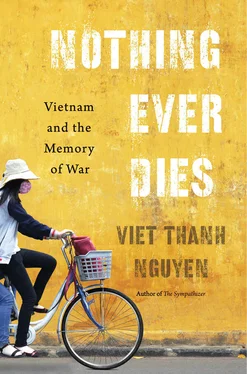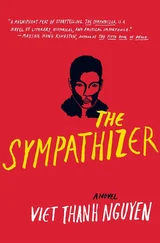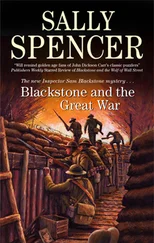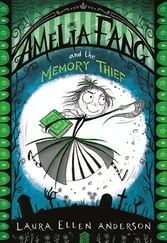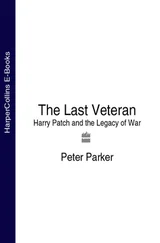Evident in this model of giving and forgiving, of letting go and surrendering, is the gratifying picture of two enemies making peace, acting out the binary of giver and receiver. The model is laudable but vulnerable because it can encourage us to overlook what does not fit this dualistic scheme. So, when it comes to my war, its complicated history is often reduced to a conflict between Vietnam and America. What happens to Laos and Cambodia, the South Vietnamese, the diversity within all of these countries? For many, it is easier to overlook these and other differences in favor of the image of (victorious) Vietnamese and (defeated) Americans reconciling. The model of two enemies making peace is also vulnerable because the reciprocity of gift giving still implies indebtedness, the expectation of getting something in return for a gift, even if it is love and friendship. Thus, the reconciliation of Vietnam and America has not actually led to peace, unless one defines peace as the lack of war. Reconciliation has led to the return of business as usual, two countries negotiating for power and profit in the former Indochina and the South China Sea region. Those invested in capitalism and militarism steer this corrupted reconciliation, which masks the self-interested exchange between the two countries. In this exchange, gifts turn into commodities and peace turns into alliances for present profit and potential war. If we wish for true peace, pure forgiveness, and just forgetting, we must remember the labor that makes commodities, we must remember the history of war that lurks behind the façade of peace.
Giving without hope of reciprocity, including the gift of art, is one model for pure forgiveness and just forgetting. Rather than think of giving as involving only two people or entities, imagine giving as part of a chain in which the gift circulates among many. The one who receives a gift need not return it but can instead give a gift to another, with the giving itself a gift. In this manner, the giver eliminates the problem of reciprocity and expectation. Critic Lewis Hyde proposes this when he discusses the work of art as a gift that the artist sends out into the world, to be passed along to others. For Hyde,
art does not organize parties, nor is it the servant or colleague of power. Rather, the work of art becomes a political force simply through the faithful representation of the spirit. It is a political act to create an image of the self or of the collective.… So long as the artist speaks the truth, he will, whenever the government is lying or has betrayed the people, become a political force whether he intends to or not. 27
Giving in its pure form is a way of forgiving the world, the one that accepts the inevitability of warfare and capitalism, blood and debt. Is not such a world unforgivable to those who wish only to give? Giving without expectation of return is a way of working toward a time when just forgetting and actual justice exist in all ways of life, including in memory. The work of art crafted in the spirit of truth is a sign of justice and points toward justice, even if it cannot completely escape the material and unjust world that can turn the gift into a thing to be bought and sold. Still, the artist who gives her gift to others remembers the gift of art given to her by other artists. She gives and forgets about any debt owed to her. This true artist hopes for an era when all people can be artists if they wish, to give if they wish, to live in a time when the just forgetting of the unjust past has happened.
To all those who demand that we must forget even without justice if we wish to move on — forgetting at all costs will one day cost you or your descendants. The violence and injustice you wish to leave in the past will return, perhaps in the old guise or perhaps in a new and deceptive one that will only be another face of perpetual war. Yes, you can forget, but you will not move on. Just forgetting only happens as a consequence of just memory. Remembering in this manner remains a task that seems impossible, given the irony that many of us prefer to carry the burden of injustice instead of putting it down, a reluctance that makes us bound to our past and present. Until that impossible moment of just memory occurs for everyone, some can undertake the task of just forgetting by giving and forgiving, working alone or, preferably, in solidarity with others.
Meanwhile, the future of memory remains unknown. On my last trip to Southeast Asia, I visit the far reaches of Cambodia to catch a glimpse of that future, to the border town of Anlong Veng, thirteen kilometers from Thailand and in a district that was the Khmer Rouge’s last bastion. It takes two hours by private car from Siem Reap, and we drive up mountain roads past an old monument to the Khmer Rouge, carved from a boulder. Someone has beheaded the statues of the Khmer Rouge soldiers who once proudly stood there. Driving past the monument and Anlong Veng, we continue to the border crossing with Thailand, where we have no difficulty finding what I am looking for. On the side of the road, a blue sign that says “Pol Pot Creamation” points to the grave. It is twenty meters away amid a camp of shacks and tarps where people live in poverty, with the ones doing well selling things like gasoline in old Johnny Walker bottles. What remains of Pol Pot lies in a small and barren dirt lot. A rope keeps out visitors, but the guard lowers it for a dollar. The dusty and neglected tomb is a knee-high, rusty tin roof over a low, rectangular mound of earth, fenced off and decorated with a few sad flowers. Here rests someone who embodied the human and the inhuman in the extreme, an idealist who learned his ideas about taking Cambodia to Year Zero in Paris, City of Light. 28The antimemorial he has at present suits him perfectly, its form as ugly as his legacy, but I can only hope that it stays that way. After all, his tomb exists almost literally in the shadow of a casino under construction a hundred meters away, across the highway. By the time I write these words, the casino should be finished, and its proximity to Pol Pot’s tomb can only lead to more tourism for both. There will be no giving here, much less forgiving.
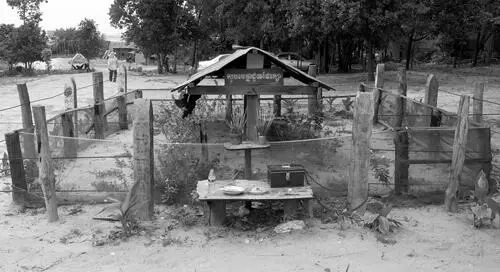
A few kilometers away down a badly cratered red earth road stands the tourist future, “Ta Mok’s House Historical Attractive Site,” marking the residence of Pol Pot’s last ally and possible murderer, nicknamed the Butcher. Hidden behind a screen of weeds and saplings is the decrepit shell of the home, its walls marked with insults against Ta Mok. In a clearing nearby, restaurants and bungalows invite people to eat, drink, and relax. A young couple cuddles in one of the bungalows as they gaze at the view of the plains beneath the mountains. Perhaps one day Pol Pot’s grave will be ringed with bars. Why not, if money is to be made from people like myself. In the small town of Anlong Veng itself there is another Ta Mok tourist attraction, a compound where he once lived. A few vanloads of Khmer tourists wander around the barren houses of the compound, devoid of furniture but still decorated with wall paintings of Angkor Wat. Children lounge on the balcony of an open-air room facing fields where the homes of other Khmer Rouge senior leaders — Pol Pot, Khieu Samphan, Ieng Sary — once stood. The homes have disappeared. A demolished truck that was Pol Pot’s mobile radio station crouches in the front yard. Under the shade of a pavilion, on cement, stand two gigantic wire chicken coops that once caged prisoners. In Ta Mok’s day, he kept the cages and the prisoners under the sun. A woman fingers a cage door and smiles, half-laughing. I doubt she finds this place funny, but as the journalist Nic Dunlop has written in regard to the genocide, “Confronted with the enormity of what had happened, how was one to react?” 29I take her picture.
Читать дальше
